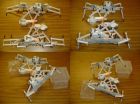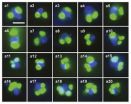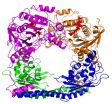(Press-News.org)
VIDEO:
A two-minute video, "Morphological Change in Machines Accelerates the Evolution of Robust Behavior, " was produced by the Morphology, Evolution and Cognition Laboratory, University of Vermont, 2011.
Click here for more information.
Want to build a really tough robot? Forget about Terminator. Instead, watch a tadpole turn into a frog.
Or at least that's not too far off from what University of Vermont roboticist Josh Bongard has discovered, as he reports in the January 10 online edition of the Proceedings of the National Academy of Sciences.
In a first-of-its-kind experiment, Bongard created both simulated and actual robots that, like tadpoles becoming frogs, change their body forms while learning how to walk. And, over generations, his simulated robots also evolved, spending less time in "infant" tadpole-like forms and more time in "adult" four-legged forms.
These evolving populations of robots were able to learn to walk more rapidly than ones with fixed body forms. And, in their final form, the changing robots had developed a more robust gait -- better able to deal with, say, being knocked with a stick -- than the ones that had learned to walk using upright legs from the beginning.
"This paper shows that body change, morphological change, actually helps us design better robots," Bongard says. "That's never been attempted before."
Bongard's research, supported by the National Science Foundation, is part of a wider venture called evolutionary robotics. "We have an engineering goal," he says "to produce robots as quickly and consistently as possible." In this experimental case: upright four-legged robots that can move themselves to a light source without falling over.
"But we don't know how to program robots very well," Bongard says, because robots are complex systems. In some ways, they are too much like people for people to easily understand them.
"They have lots of moving parts. And their brains, like our brains, have lots of distributed materials: there's neurons and there's sensors and motors and they're all turning on and off in parallel," Bongard says, "and the emergent behavior from the complex system which is a robot, is some useful task like clearing up a construction site or laying pavement for a new road." Or at least that's the goal.
But, so far, engineers have been largely unsuccessful at creating robots that can continually perform simple, yet adaptable, behaviors in unstructured or outdoor environments.
Which is why Bongard, an assistant professor in UVM's College of Engineering and Mathematical Sciences, and other robotics experts have turned to computer programs to design robots and develop their behaviors -- rather than trying to program the robots' behavior directly.
His new work may help.
Using a sophisticated computer simulation, Bongard unleashed a series of synthetic beasts that move about in a 3-dimensional space. "It looks like a modern video game," he says. Each creature -- or, rather, generations of the creatures -- then run a software routine, called a genetic algorithm, that experiments with various motions until it develops a slither, shuffle, or walking gait -- based on its body plan -- that can get it to the light source without tipping over.
"The robots have 12 moving parts," Bongard says. "They look like the simplified skeleton of a mammal: it's got a jointed spine and then you have four sticks -- the legs -- sticking out."
Some of the creatures begin flat to the ground, like tadpoles or, perhaps, snakes with legs; others have splayed legs, a bit like a lizard; and others ran the full set of simulations with upright legs, like mammals.
And why do the generations of robots that progress from slithering to wide legs and, finally, to upright legs, ultimately perform better, getting to the desired behavior faster?
"The snake and reptilian robots are, in essence, training wheels," says Bongard, "they allow evolution to find motion patterns quicker, because those kinds of robots can't fall over. So evolution only has to solve the movement problem, but not the balance problem, initially. Then gradually over time it's able to tackle the balance problem after already solving the movement problem."
Sound anything like how a human infant first learns to roll, then crawl, then cruise along the coffee table and, finally, walk?
"Yes," says Bongard, "We're copying nature, we're copying evolution, we're copying neural science when we're building artificial brains into these robots." But the key point is that his robots don't only evolve their artificial brain -- the neural network controller -- but rather do so in continuous interaction with a changing body plan. A tadpole can't kick its legs, because it doesn't have any yet; it's learning some things legless and others with legs.
And this may help to explain the most surprising -- and useful -- finding in Bongard's study: the changing robots were not only faster in getting to the final goal, but afterward were more able to deal with new kinds of challenges that they hadn't before faced, like efforts to tip them over.
Bongard is not exactly sure why this is, but he thinks it's because controllers that evolved in the robots whose bodies changed over generations learned to maintain the desired behavior over a wider range of sensor-motor arrangements than controllers evolved in robots with fixed body plans. It seem that learning to walk while flat, squat, and then upright, gave the evolving robots resilience to stay upright when faced with new disruptions. Perhaps what a tadpole learns before it has legs makes it better able to use its legs once they grow.
"Realizing adaptive behavior in machines has to date focused on dynamic controllers, but static morphologies," Bongard writes in his PNAS paper "This is an inheritance from traditional artificial intelligence in which computer programs were developed that had no body with which to affect, and be affected by, the world."
"One thing that has been left out all this time is the obvious fact that in nature it's not that the animal's body stays fixed and its brain gets better over time," he says, "in natural evolution animals bodies and brains are evolving together all the time." A human infant, even if she knew how, couldn't walk: her bones and joints aren't up to the task until she starts to experience stress on the foot and ankle.
That hasn't been done in robotics for an obvious reason: "it's very hard to change a robot's body," Bongard says, "it's much easier to change the programming inside its head."
Still, Bongard gave it a try. After running 5000 simulations, each taking 30 hours on the parallel processors in UVM's Vermont Advanced Computing Center -- "it would have taken 50 or 100 years on a single machine," Bongard says—he took the task into the real world.
"We built a relatively simple robot, out of a couple of Lego Mindstorm kits, to demonstrate that you actually could do it," he says. This physical robot is four-legged, like in the simulation, but the Lego creature wears a brace on its front and back legs. "The brace gradually tilts the robot," as the controller searches for successful movement patterns, Bongard says, "so that the legs go from horizontal to vertical, from reptile to quadruped.
"While the brace is bending the legs, the controller is causing the robot to move around, so it's able to move its legs, and bend its spine," he says, "it's squirming around like a reptile flat on the ground and then it gradually stands up until, at the end of this movement pattern, it's walking like a coyote."
"It's a very simple prototype," he says, "but it works; it's a proof of concept."
INFORMATION:
For robust robots, let them be babies first
2011-01-21
ELSE PRESS RELEASES FROM THIS DATE:
Gene test shows which bladder cancer patients may have cancer spread
2011-01-21
AURORA, Colo. (Jan. 20, 2011)--Cancer scientists have designed the first molecular test to predict which bladder cancer patients may have cancer involvement in their lymph nodes at the time of surgery—which could help doctors determine which patients are good candidates for pre-surgical, or neo-adjuvant, chemotherapy.
The test analyzes 20 genes on tumor biopsies, according to a paper published online Jan. 20, 2011, in Lancet Oncology.
"Randomized clinical trials have shown that giving neo-adjuvant chemotherapy extends patient lives, but only 5 to 15 percent of patients ...
UC Davis study shows plants moved downhill, not up, in warming world
2011-01-21
In a paper published today in the journal Science, a University of California, Davis, researcher and his co-authors challenge a widely held assumption that plants will move uphill in response to warmer temperatures.
Between 1930 and 2000, instead of colonizing higher elevations to maintain a constant temperature, many California plant species instead moved downhill an average of 260 feet, said Jonathan Greenberg, an assistant project scientist at the UC Davis Center for Spatial Technologies and Remote Sensing.
"While the climate warmed significantly in this period, ...
Simple, ingenious way to create lab-on-a-chip devices could become a model for teaching and research
2011-01-21
With little more than a conventional photocopier and transparency film, anyone can build a functional microfluidic chip.
A local Cambridge high school physics teacher invented the process; now, thanks to a new undergraduate teaching lab at Harvard's School of Engineering and Applied Sciences (SEAS), students will be able explore microfluidics and its applications.
The Microfluidics Lab, developed by Dr. Anas Chalah, Director of Instructional Technology at SEAS, takes advantage of a simple but ingenious new method of creating lab-on-a-chip devices that are quick to produce, ...
Speaking the same language means better health care quality, Wayne State University study finds
2011-01-21
DETROIT—Wayne State University researchers have found that when patients and providers speak the same language, patients report less confusion and better health care quality. The findings were based on data from the Pew Hispanic Center/Robert Wood Johnson Foundation's Latino Health Survey.
Understanding the relationship between language and health care quality has important public health implications for providing services in an increasingly diverse U.S. population, according to Hector M. González, Ph.D., assistant professor of family medicine and public health at WSU's ...
Strong social ties benefit breast cancer patients
2011-01-21
Breast cancer patients who have a strong social support system in the first year after diagnosis are less likely to die or have a recurrence of cancer, according to new research from Vanderbilt-Ingram Cancer Center (VICC) and the Shanghai Institute of Preventive Medicine. The study, led by first author Meira Epplein, Ph.D., assistant professor of Medicine at VICC, was published in a recent edition of the Journal of Clinical Oncology.
Patients in the study were enrolled in the Shanghai Breast Cancer Survivor Study, a large, population-based review of female breast cancer ...
Newly discovered group of algae live in both fresh water and ocean
2011-01-21
A team of biologists has discovered an entirely new group of algae living in a variety of marine and freshwater environments. This group of algae, which the researchers dubbed "rappemonads," have DNA that is distinctly different from that of other known algae. In fact, humans and mushrooms are more closely related to each other than rappemonads are to some other common algae (such as green algae). Based on their DNA analysis, the researchers believe that they have discovered not just a new species or genus, but a potentially large and novel group of microorganisms.
The ...
Red blood cell hormone modulates the immune system
2011-01-21
New research reveals that a hormone best known for stimulating the production of red blood cells can modulate the immune response. The study, published by Cell Press in the January 27th issue of the journal Immunity, finds that erythropoietin (EPO) has contrasting influences on infectious and inflammatory diseases and may be useful in the design of new therapeutic strategies.
EPO is a cytokine hormone that stimulates the production of red blood cells by acting at EPO receptors (EPORs) on red blood cell precursors. Interestingly, other cell types also express EPORs. ...
Controlling symptoms can lead to improved quality of life for end-of-life patients
2011-01-21
LOUISVILLE, Ky. – Healthcare workers can most directly affect quality of life (QOL) of patients with advanced stage lung cancer by helping manage symptoms such as pain, lack of energy, shortness of breath, coughing, difficulty sleeping and dry mouth, according to a study recently published in the journal Oncology Nursing Forum.
Understanding the symptoms, particularly symptom distress - or the degree to which a symptom bothers a person, is crucial to improved patient care. Intervention at the time of diagnosis is important because patients with stage IIIb or IV lung cancer ...
Go figure: Math model may help researchers with stem cell, cancer therapies
2011-01-21
The difficult task of sorting and counting prized stem cells and their cancer-causing cousins has long frustrated scientists looking for new ways to help people who have progressive diseases.
But in a development likely to delight math teachers, University of Florida researchers have devised a series of mathematical steps that accomplishes what the most powerful microscopes, high-throughput screening systems and protein assays have failed to do — assess how rapidly stem cells and their malignant, stemlike alter egos increase their numbers.
The method, published in the ...
How the hat fits: Structural biology study reveals shape of epigenetic enzyme complex
2011-01-21
To understand the emerging science of epigenetics—a field that describes how genes may be regulated without altering the underlying DNA itself—scientists are deciphering the many ways in which enzymes act on the proteins surrounding DNA within cells.
One type of these enzymes, proteins known as histone acetyltransferases (HATs), act on DNA by modifying DNA-bound proteins called histones. This act of modification, called acetlyation, can dictate how histones interact with DNA and other proteins affecting processes such as DNA replication, transcription (reading the gene), ...




